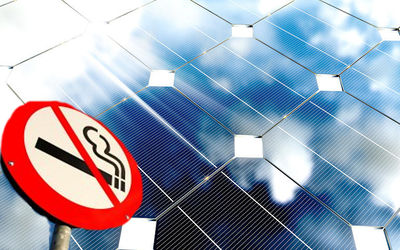J.M.Pearce (talk | contribs) (Created page with "{{MOST}} {{Pearce-pubs}} ==Source== right|400px * Prannay R. Malu, Utkarsh S. Sharma, Joshua M. Pearce. [https://doi.org/10.1016/j.seta.2017.08.004 A...") |
J.M.Pearce (talk | contribs) mNo edit summary |
||
| Line 4: | Line 4: | ||
==Source== | ==Source== | ||
[[image:Nosmoke-pv.jpg|right|400px]] | [[image:Nosmoke-pv.jpg|right|400px]] | ||
* | * R. Krishnan and J. M. Pearce. [https://doi.org/10.1016/j.landusepol.2018.01.010 Economic impact of substituting solar photovoltaic electric production for tobacco farming]. ''Land Use Policy", 72, (2018), pp. 503–509. doi: 10.1016/j.landusepol.2018.01.010 [ open access] | ||
==Abstract== | ==Abstract== | ||
Solar photovoltaic (PV) technology represents a promising method to prevent dangerous global climate change, however full solar penetration demands substantial surface areas, possibly encroaching on arable land. To avoid repeating the mistakes of previous attempts to convert agricultural land to energy, arable land currently used for crops with known health hazards can be considered for conversion. Tobacco is the leading cause of avoidable death globally, and despite increasingly stringent controls on tobacco, economics provides an incentive to continue tobacco production. However, with the economics of PV ever improving, this study investigates the potential economic benefits of photovoltaic conversion of farms during tobacco's decline. This study analyzes key factors influencing conventional tobacco farming economics in the U.S. over a sensitivity of realistic future values. Then tobacco crop profit is compared to a sensitivity analysis covering the profits of solar PV farming on the same land. The results show that considering existing electric prices, escalation rates, and installed costs, PV farm substitution for tobacco farming makes economic sense in many U.S. cases already. In a case study of North Carolina, 30GW of PV power capacity was found to be economically viable on existing tobacco farms and if conversion took place over 2000 premature deaths could be prevented from pollution reduction alone. This meets the State's peak summer loads. Land use policies are discussed to facilitate such land use conversions for the benefit of the economy, the environment and human health. | |||
==Highlights== | ==Highlights== | ||
| Line 18: | Line 18: | ||
==Keywords== | ==Keywords== | ||
Agriculture; | Agriculture; | ||
[[Photovoltaic]]; | [[Photovoltaic]]; | ||
Farming; | Farming; | ||
Solar farm; | Solar farm; | ||
Economics | Economics | ||
Land use; | Land use; | ||
Economic impact; | |||
Tobacco | |||
==Method== | ==Method== | ||
| Line 43: | Line 42: | ||
[[Category:Solar energy]] | [[Category:Solar energy]] | ||
[[Category:Photovoltaics]] | [[Category:Photovoltaics]] | ||
[[Category:public health]] | |||
Revision as of 10:48, 3 February 2018
Source

- R. Krishnan and J. M. Pearce. Economic impact of substituting solar photovoltaic electric production for tobacco farming. Land Use Policy", 72, (2018), pp. 503–509. doi: 10.1016/j.landusepol.2018.01.010 [ open access]
Abstract
Solar photovoltaic (PV) technology represents a promising method to prevent dangerous global climate change, however full solar penetration demands substantial surface areas, possibly encroaching on arable land. To avoid repeating the mistakes of previous attempts to convert agricultural land to energy, arable land currently used for crops with known health hazards can be considered for conversion. Tobacco is the leading cause of avoidable death globally, and despite increasingly stringent controls on tobacco, economics provides an incentive to continue tobacco production. However, with the economics of PV ever improving, this study investigates the potential economic benefits of photovoltaic conversion of farms during tobacco's decline. This study analyzes key factors influencing conventional tobacco farming economics in the U.S. over a sensitivity of realistic future values. Then tobacco crop profit is compared to a sensitivity analysis covering the profits of solar PV farming on the same land. The results show that considering existing electric prices, escalation rates, and installed costs, PV farm substitution for tobacco farming makes economic sense in many U.S. cases already. In a case study of North Carolina, 30GW of PV power capacity was found to be economically viable on existing tobacco farms and if conversion took place over 2000 premature deaths could be prevented from pollution reduction alone. This meets the State's peak summer loads. Land use policies are discussed to facilitate such land use conversions for the benefit of the economy, the environment and human health.
Highlights
- Large arable land conversion to solar PV farms to meet growing demand.
- Decline in tobacco farming economics, potential arable land for PV farming.
- Growing PV economics, sensitivity analysis on tobacco and PV farming key factors.
- Calculation of tobacco and PV farming profit over 25 years with various sensitivities.
- Many cases where PV farming is more profitable than tobacco farming.
Keywords
Agriculture; Photovoltaic; Farming; Solar farm; Economics Land use; Economic impact; Tobacco





